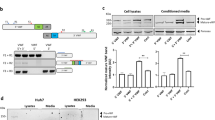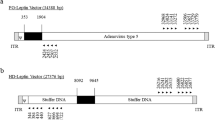Abstract
In utero somatic gene therapy in the later stages of pregnancy may allow targeting of organ systems which are difficult to reach later in life and to prevent the development of tissue damage otherwise caused by the early onset of inherited diseases. We report here on the percutaneous delivery of two adenoviral vectors, containing the β-galactosidase reporter gene and the human Factor IX gene respectively, to the fetal liver and circulation by ultrasound-guided umbilical vein puncture similar to procedures used in human pregnancy. Vector spread, as detected by PCR analysis for the β-galactosidase encoding vector, was found in almost all fetal and neonatal organs and in the maternal liver. Expression of the β-galactosidase transgene was detected in many fetal tissues by RT-PCR. High β-galactosidase production was shown by immuno-histochemistry predominantly in the liver, where about 30% of the hepatocytes stained positive, and in the adrenal cortex. Production of factor IX was determined by ELISA in the plasma of treated fetuses and newborn lambs and reached at birth up to 80% of the normal human plasma concentration. This demonstrates a very hopeful proof of principle for the development of prenatal treatment of many genetic diseases but also requires more detailed investigations with respect to the observed systemic spread of the vector.
This is a preview of subscription content, access via your institution
Access options
Subscribe to this journal
Receive 12 print issues and online access
$259.00 per year
only $21.58 per issue
Buy this article
- Purchase on Springer Link
- Instant access to full article PDF
Prices may be subject to local taxes which are calculated during checkout






Similar content being viewed by others

References
Coutelle C, Douar A-M, College WH, Froster U . The challenge of fetal gene therapy Nature Med 1995 1: 864–866
Douar A-M, Themis M, Coutelle C . Fetal somatic gene therapy Hum Molec Rep 1996 2: 633–641
McCray PB et al. Adenoviral-mediated gene transfer to fetal pulmonary epithelia in vitro and in vivo J Clin Invest 1995 95: 2620–2632
Pitt BR et al. Retrovirus-mediated gene transfer in lungs of living fetal sheep Gene Therapy 1995 2: 344–350
Vincent MC et al. Adenovirus-mediated gene transfer to the respiratory tract of fetal sheep in utero Hum Gene Ther 1995 6: 1019–1028
Holzinger A et al. Intra-amniotic administration of an adenovirus vector for gene transfer to fetal sheep and mouse tissue Ped Res 1995 38: 844–850
Sekhon HS, Larson JE . In utero gene transfer into the pulmonary epithelium Nature Med 1995 1: 1201–1203
Larson J et al. Reversal of cystic fibrosis phenotype in mice by gene therapy in utero Lancet 1997 349: 619–620
Douar AM et al. Foetal gene delivery in mice by intra-amniotic administration of retroviral producer cells and adenovirus Gene Therapy 1997 4: 883–890
Wang et al. Ultrasound-guided gene delivery to hepatocytes in utero Fetal Diagn Ther 1998 13: 187–205
Weiner CP, Okamura K . Diagnostic fetal blood sampling technique-related losses Fetal Diagn Ther 1996 11: 169–175
Jensen A, Berger R . Fetal circulatory responses to oxygen lack J Dev Physiol 1991 16: 181–207
Couzin J . RAC confronts in utero gene therapy proposal Science 1998 282: 27
Billings PRS, Schneider H, Coutelle C . In utero gene therapy Nature Med 1999 5: 255–257
Porada C et al. In utero gene therapy: transfer and long-term expression of the bacterial neo(r) gene in sheep after direct injection of retroviral vectors into preimmune fetuses Hum Gene Ther 1998 9: 1571–1585
Smith TAF et al. Adenovirus mediated expression of therapeutic plasma levels of human factor IX in mice Nat Genet 1993 5: 397–402
Kay MA et al. In vivo gene therapy of hemophilia B: sustained partial correction in factor IX-deficient dogs Science 1993 262: 117–119
Ferkol T et al. Regulation of the phosphoenolpyruvate carboxykinase/human factor IX gene introduced into the livers of adult rats by receptor-mediated gene transfer FASEB J 1993 7: 1081–1091
Fang B et al. Gene therapy for hemophilia B: host immunosuppression prolongs the therapeutic effect of adenovirus-mediated factor IX expression Hum Gene Ther 1995 6: 1039–1044
Walter J et al. Successful expression of factor IX following repeat administration of an adenoviral vector in mice Proc Natl Acad Sci USA 1996 93: 3056–3061
Koerberl D et al. Persistent expression of human clotting factor IX from mouse liver after intravenous injection of adeno-associated virus vectors Proc Natl Acad Sci USA 1997 94: 1426–1431
Snyder RO et al. Correction of hemophilia B in canine and murine models using recombinant factor IX adeno-associated viral vectors Nature Med 1999 5: 64–70
Morral NP et al. High doses of helper-dependent adenoviral vector yield supraphysiological levels of alpha1 antitrypsin with negligible toxicity Hum Gene Ther 1998 9: 2709–2716
Wilke M et al. Complementation of the genetic defect in Gunn rat hepatocytes in vitro by highly efficient gene transfer with cationic liposomes Gene Therapy 1997 4: 1305–1312
Hara T, Tan Y, Huang L . In vivo gene delivery to the liver using reconstituted chylomicron remnants as a novel nonviral vector Proc Natl Acad Sci USA 1997 94: 14547–14552
Harbottle RP et al. An Arg-Gly-Asp/oligolysine peptide; a prototype construct for integrin mediated gene delivery Hum Gene Ther 1998 9: 1037–1047
Sadaie M et al. Towards developing HIV-2 lentivirus-based retroviral vectors for gene therapy: dual gene expression in the context of HIV-2 LTR and Tat J Med Vrol 1998 54: 118–128
Blomer U et al. Highly efficient and sustained gene transfer in adult neurons with a lentivirus vector J Virol 1997 71: 6641–6649
Herzog RW et al. Long-term correction of canine hemophilia B by gene transfer of blood coagulation factor IX mediated by adeno-associated viral vector Nature Med 1999 5: 56–63
Stratford-Perricaudet LD, Makeh I, Pericaudet M, Briand P . Widespread long-term gene transfer to mouse skeletal muscles and heart J Clin Invest 1992 90: 626–630
Graham FL, Eb AJvd . A new technique for the assay of infectivity of human adenovirus 5 DNA Virology 1973 52: 456–457
Chartier C et al. Efficient generation of recombinant adenovirus vectors by homologous recombination in Escherichia coli J Virol 1996 70: 4805–4810
Graham FL, Smiley J, Russel WC, Nairn R . Characteristics of a human cell line transformed by DNA from human adenovirus type 5 J Gen Virol 1977 36: 59–72
Acknowledgements
This work was supported by grants from SPARKS and the Leopold Muller Bequest/CF Trust. MT is funded by the Leopold Muller Bequest/CF Trust, SJ by the MRC, SA by the Sir Jules Thorne Charitable Trust and HS by the Deutsche Forschungsgemeinschaft. We wish to express our gratitude to Ms Irene Hopton-Scott, Dr Hidenori Nishina, Dr Takashi Ozaki, Mr James Newman, Ms Suzy Buckley and Ms Henrietta Price for their much appreciated organisational or experimental support during this experiment.
Author information
Authors and Affiliations
Rights and permissions
About this article
Cite this article
Themis, M., Schneider, H., Kiserud, T. et al. Successful expression of β-galactosidase and factor IX transgenes in fetal and neonatal sheep after ultrasound-guided percutaneous adenovirus vector administration into the umbilical vein. Gene Ther 6, 1239–1248 (1999). https://doi.org/10.1038/sj.gt.3300970
Received:
Accepted:
Published:
Issue Date:
DOI: https://doi.org/10.1038/sj.gt.3300970
Keywords
This article is cited by
-
Mechanistic Insights into Factor VIII Immune Tolerance Induction via Prenatal Cell Therapy in Hemophilia A
Current Stem Cell Reports (2019)
-
In utero stem cell transplantation and gene therapy: rationale, history, and recent advances toward clinical application
Molecular Therapy - Methods & Clinical Development (2016)
-
Systemic delivery of scAAV9 in fetal macaques facilitates neuronal transduction of the central and peripheral nervous systems
Gene Therapy (2013)
-
Intra-amniotic Delivery of CFTR-expressing Adenovirus Does Not Reverse Cystic Fibrosis Phenotype in Inbred CFTR-knockout Mice
Molecular Therapy (2008)
-
Evaluation of prenatal intra-amniotic LAMB3 gene delivery in a mouse model of Herlitz disease
Gene Therapy (2006)


